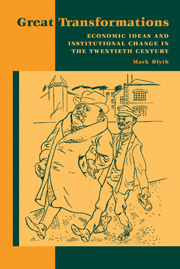Book contents
- Frontmatter
- Contents
- Preface
- Acknowledgments
- PART I THEORY
- PART II CASES
- 3 Building American Embedded Liberalism
- 4 Building Swedish Embedded Liberalism
- 5 Disembedding Liberalism: Ideas to Break a Bargain
- 6 Disembedding Liberalism in the United States
- 7 Disembedding Liberalism in Sweden
- PART III CONCLUSIONS
- Index
4 - Building Swedish Embedded Liberalism
Published online by Cambridge University Press: 05 June 2012
- Frontmatter
- Contents
- Preface
- Acknowledgments
- PART I THEORY
- PART II CASES
- 3 Building American Embedded Liberalism
- 4 Building Swedish Embedded Liberalism
- 5 Disembedding Liberalism: Ideas to Break a Bargain
- 6 Disembedding Liberalism in the United States
- 7 Disembedding Liberalism in Sweden
- PART III CONCLUSIONS
- Index
Summary
Swedish economic ideas were markedly different from their American counterparts. Yet, in spite of their different starting points, by 1943–4 both sets of ideas had converged to a remarkable degree. Unlike the United States, where a variety of economic ideas were deployed rather haphazardly, in Sweden the content and sequencing of economic ideas were remarkably clear-cut. The 1920s were, as Benny Carlson notes, “the decade of economic liberalism's gala performance.” Swedish academic economics dominated both popular and elite thinking about the nature of the economy and the role of the state. Unfortunately, given the manifest failure of classical liberal doctrines to actually halt the depression, a group of younger scholars based principally at the Stockholm School of Economics began to develop alternative ideas relating underconsumption and unemployment. Due to their institutional links to the Swedish Social Democratic Party, Sveriges Socialdemokratiska Arbetareparti (SAP), these new younger economists, many of whom were not Social Democrats, were able to turn these new ideas into state policy quickly. Before analyzing how such ideas effected Swedish institutional development, however, we must appreciate the different political developmental trajectories of Sweden and the United States.
First, in contrast to every leading industrialized nation, the party of the democratic left, the SAP, has been in power in Sweden for over 80 percent of the time since the introduction of the franchise in December 1918.
- Type
- Chapter
- Information
- Great TransformationsEconomic Ideas and Institutional Change in the Twentieth Century, pp. 96 - 125Publisher: Cambridge University PressPrint publication year: 2002



